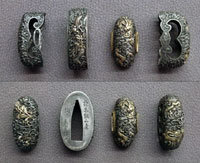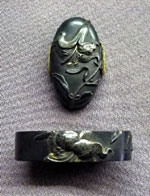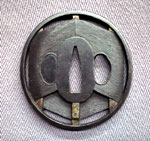2)鐔 雷神図
Design: God of thunder.
SOLD |
 |
2) 鐔 雷神図
寸法:縦72.0×横72.0×厚さ5.0 (mm)
解説:雷(神鳴り)に対して自分より強い不可抗の力を持つ存在として畏怖と尊敬の
念を持っていた。輪形に連ねてある太鼓を力強く叩く雷神が表裏に描かれている。
江戸時代中期。(18世紀)
Design: God of thunder. 18th century
|
4) 揃金具 波龍図
Design of dragons with wavy.
SOLD |
 |
4) 揃金具 波龍図 縁銘 於東叡山邊 駒井美喬造之
縁) 縦42.5×横26.0×高さ12.5 (mm)
作者の駒井美喬(よしたか)は天保12年(1841)に生まれ、大正5年(1916)に没するまで
江戸で活躍した金工師。銘文にある東叡山は、現在の上野・寛永寺辺りを指す。
銀地に躍動的な龍と波が緻密に表現されており、作者の技量がよく発揮されている優品。
保存鑑定書付。
Design of dragons with wavy made by Komai Yoshitaka (1841-1916) who was active
at Tokyo. It is described that he made this sword fittings at To-ei-zan
(present around Ueno area). This is a set of sword fittings, Fuchi-kashira,
Kurikata
and Kojiri. Active dragons with wavy are depicted on the silver grounds
well, and the
details is so excellent. Hozon certificate paper.
|
6) 縁頭 百合図 銘 遊洛斎赤文
Design: Lily by Yurakusai Sekibun (first generation of Sekibun)
SOLD |
 |
 |
 |
6) 縁頭 百合図 銘 遊洛斎赤文
寸法:(縁) 縦39.5×横24.0×厚さ9.5 (mm) (頭) 縦36.0×横21.0×厚さ10.5 (mm)
解説:寛政元年(1789)- 明治8年(1875)没。遊洛斎赤文(初代)は越後国に生まれ
文政7年(1824)江戸で庄内藩酒井家のお抱え工となる。赤銅石目地に高彫据紋象嵌で
仕上げられた本作は、江戸で浜野派に学び、また京都でも修行したと云われる技量を
窺い知る事ができる優品。保存鑑定書付。阿弥屋箱書有り。
「庄内金工名作集」(佐藤寒山著、1966年発行)所載。(P. 211)
Design: Lily by Yurakusai Sekibun (first generation of Sekibun)
Yurakusai Sekibun (1789- 1875) came from Echigo province
(present Niigata prefecture),and was employed by distinguished feudal lord,
Sakai Family who ruled Shonai clan (present Yamagata prefecture) when he
was
in Edo in 1824.
This excellent piece is illustrated on "Masterpiece of Shonai metal
worker",
written by Sato Kanzan in 1966 (P.211).
Hozon certificate paper. Description by Amiya who is a consultantfor fine
sword
fittings is on the attached wood box.
|
4) 鐔 糸巻透図 無銘 丹州定正
Design of a reel of thread
SOLD |
 |
 |
4) 鐔 糸巻透図 無銘 丹州定正
寸法:縦73.0×横69.0×厚さ5.5 (mm)
解説:機(はた)織道具の一つで、織姫の持ち物として七夕と関連が深い糸巻を
糸の質感柔らかに仕上げている。定正は丹後国(現在の京都府北部)の鐔工で
寛文頃より同名が数代いる。江戸時代中期。保存鑑定書付。
Reel of thread is often depicted with Orihime (Vega) as her belonging,
and
relate to the Tanabata story.Wounded each thread is fine depiction, and
shows
a good craftsmanship of this maker,Sadamasa who have several generations
of
this name in Tango (present the northern part of Kyoto).
Circa 1670-1750. Hozon certificate paper. |